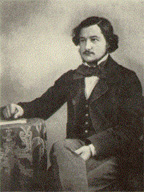![]()
Natural Victorian
Cotton Products

Woven By Water® Presents: The Life of William Morris
WILLIAM MORRIS was born the first son in a family of nine children in Walthamstow, northeast of London. He was raised and educated a child of Victorian privilege. He completed his formal education at Oxford and it was here that his life's direction changed from aspiring cleric to inspiring artist-craftsman and advocate for social change.
As a young man, he began to lament the industrialization and mass-production of the Victorian Era, which he believed had impoverished craftsmen and resulted in shoddy, uninspiring work. In the spring of 1861, having decided that all the minor arts were in a state of "complete degradation", he chose "to set up a sort of shop" where he and six of his friends could produce and sell painted furniture, stained glass and embroidered and decorative articles. It became known as "The Firm". Later, to be re-named "Morris & Co". |
|
His decorating style was revolutionary because it was natural in an age just embracing mass-production and lower standards in quality, color and design. Morris was such a perfectionist about color that for weeks his hands were dyed blue as he sloshed around in the dye vats (I'd have liked to have seen that), searching for the perfect hue.
Arguably everything Morris did was imbued with his views about art and craft. As one of the Founders of the Arts and Crafts Movement, one of his goals was to reform the domestic environment. 'Have nothing in your home that you do not know to be useful or believe to be beautiful,' Morris advised.
|
High standards of design and finish were central to Morris' notion of good work and it was this refusal to compromise that ensured his continuing reputation and let to the enduring success of his work. "There is no excuse," he wrote, "for doing anything which is not strikingly beautiful." He went on to live his life with immense energy and commitment. In 1859 he married Jane Burden and with Jane raised two daughters Jane Alice (Jenny) born 1861 and the following year Mary (May). |
In the early 1860s he designed two wallpapers, "Daisy" and "Trellis". Both designs were registered in February 1864. The Daisy pattern was directly inspired by a wall-hanging depicted in a 15th-century manuscript of Froissart's Chronicles. Morris original pattern drawings were then transferred onto woodblocks for printing onto fabric. "Daisy " was the first pattern to be printed in 1864. The original color way was in blue with off white, grass green and light madder red accents. Daisy was Morris & Co's best selling design for over 50 years.

Morris once confessed his fear that the work of Morris & Company was "going to be of no influence on the future." His fears, clearly, were misplaced. Although the Firm closed its doors at the beginning of the Second World War, Morris's various endeavors in stained glass, pattern-designing, and book printing, and his philosophies of art have endured in the visionary transformation of interior design to an art. In changing the way we look at our homes, Morris changed the way we look at the world.

"The true secret of happiness lies in taking a genuine interest in all the details of daily life. " William Morris







